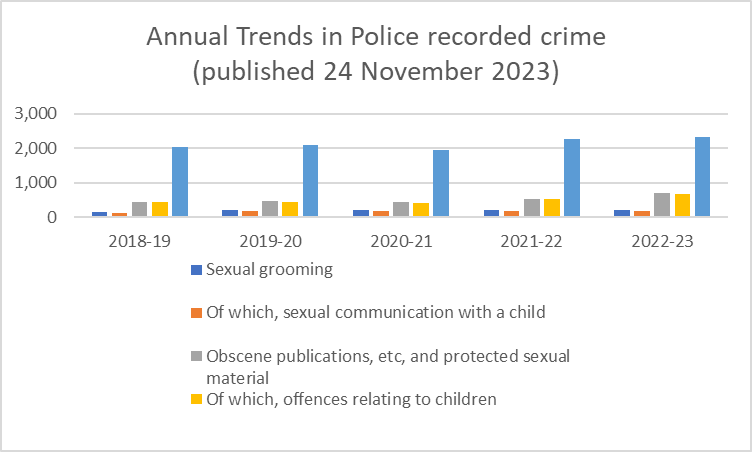- A recent PSNI press release provided some figures in relation to online offences against children in 2023.
- It said that, between 2022 and 2023, recorded crimes relating to child pornography – rather than online grooming, specifically – were up by 40.6%.
- The police publish detailed stats annually. These cover each tax year rather than calendar years, but the most recent dataset also suggests it is sharing or creation of indecent images, rather than grooming, that has increased to this degree.
On 6 February in a post on social media, the Derry Journal claimed:
“The mother of two children who were groomed by someone pretending to be a child on social media has spoken of the devastating impact after a 40.6 per cent increase in such child sex offending across the North last year.”
The post linked to a news article from the same day which contained exactly the same wording in its subheading, as well as the following:
“Zoe, not her real name, spoke out on Safer Internet Day, February 6, 2024, as the PSNI revealed 2,300 sexual offences against children were recorded in 2023, 200 of which related to grooming and sexual communication with a child.
“There were 848 offences relating to taking, possessing, sharing or publishing indecent images of children in 2023, a 40.6% increase on 2022.”
There is an apparent contradiction here.
The first quote states that online grooming increased by 40.6% between 2022 and 2023, whereas the second set of quotes says that it was child pornography offences, rather than grooming, that increased by that proportion.
According to official figures released by police, the latter is true – meaning the original claim is inaccurate.
FactCheckNI contacted the Derry Journal reporter who wrote the story but, at the time of writing, had received no reply.
- Sources
The Derry Journal article covers a lot of the same ground as a 6 February press release issued by the Police Service of Northern Ireland (PSNI).
That press release states:
“Sadly, online sexual offences against children are becoming an increasing crime type in Northern Ireland. There were 2,300 sexual offences against children recorded in 2023, 200 of which relate to grooming and sexual communication with a child.
“848 offences relating to taking, possessing, sharing or publishing indecent images of children were reported in 2023, a 40.6% increase on 2022.”
This states clearly that it was recorded offences of child pornography that increased by 40.6% in 2023, rather than online grooming.
Let’s take a closer look at PSNI data.
- Figures
Recorded crime figures for Northern Ireland, published by the PSNI, are available for all years from 1998-99 up until 2022-23.
Annual crime figures are not generally broken down by calendar year. Instead, they cover the period 1 April to 31 March.
Those annual statistics include figures for:
- Sexual grooming
- Sexual communication with a child (which is a subcategory of sexual grooming)
- Offences relating to obscene publications etc and protected sexual material
- A subcategory of that offence relating
- Total sexual offences involving children

Figure 1 – source: PSNI annual data of recorded crimes
This covers a different period than the PSNI press release cited above. For these annual figures, the latest data related to 1 April 2022 until 31 March 2023.
Accordingly, the figures are different. However, between 2021-22 and 2022-23:
- The number of sexual grooming offences involving sexual communication with a child rose from 197 to 198, an increase of 0.5%.
- Obscene publications/protected sexual material relating to children went from 521 to 690, a rise of 32.4%.
- Total sexual offences involving a victim under 18 moved from 2,267 to 2,324 – up 2.5%.
- What the figures say, and don’t say
Despite not covering precisely the same time, it does provide some supporting evidence that child pornography offences, rather than online grooming, is what has seen a large jump in recorded crimes.
PSNI does provide monthly updates of recorded crime figures. However, monthly figures are subject to change and the annual figures are generally more robust.
More importantly, the monthly figures are not as detailed as the final annual information – for instance, they include the total number of “sexual offences” but do not break that data down into subcategories. This means that the publicly-available monthly figures are not suitable for a deeper analysis of this claim and the associated trends in crime.
However, the existing annual figures provide some indicative support for the press release – which, regardless, amounts to confirmed figures from an official source.
Taking everything into account, the original claim is inaccurate.
More details about the PSNI’s campaign on online safety are available here.




